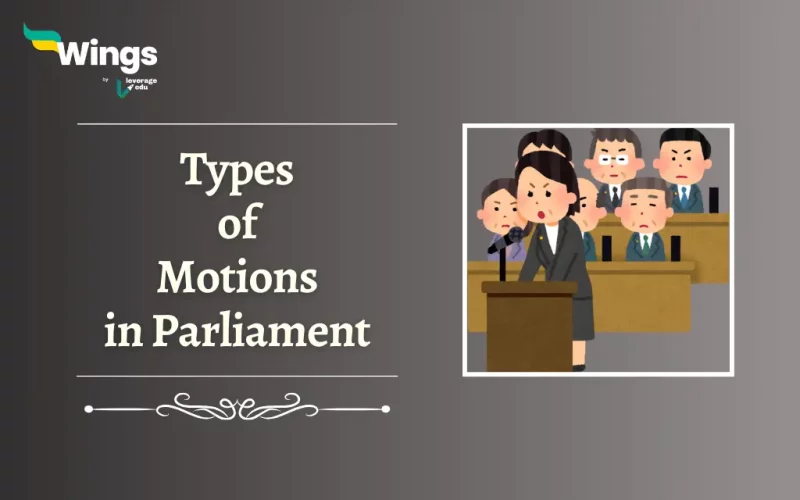Motions are formal proposals submitted by Members of Parliament (MPs) in both houses, the Lok Sabha (lower house) and the Rajya Sabha (upper house) to start discussions on different subjects. Moreover, these Motions function as important means for MPs to hold the Government accountable, voice their opinions, and seek clarifications on matters of public interest. There are several types of motions in the Indian Parliament, each with a specific purpose as well as procedure.
Types of Motions
In addition, here is a table of the 8 Types of Motions in Parliament:
| Types of Motions in the Indian Parliament | |
| Motion Type | Brief about the Motion |
| Closure Motion | A Closure Motion is moved by a member to cut short the debate on a matter before the House. -If the motion is approved by the House, the debate is stopped immediately and the matter is put to vote. |
| Privilege Motion | Privilege Motion is moved by a member when he feels that a minister has committed a breach of privilege of the House or one or more of its members by withholding facts of a case or by giving wrong or distorted facts. |
| Calling Attention Motion | A member moves for this motion to call the attention of a minister to a matter of urgent public importance, and to seek an authoritative statement from them on that matter. -The Calling Attention Motion is an Indian innovation in the parliamentary procedure and has been in existence since 1954. -The Rules of Procedure does mention it. |
| Adjournment Motion | It draws the attention of the House to a definite matter of urgent public importance and needs the support of 50 MPs to be admitted. -It is regarded as an extraordinary device since it interrupts the normal business of the House. -The Rajya Sabha cannot use this Motion as it is a motion to censure the government. -The discussion should last more than 2 hours and 30 minutes. |
| No-Confidence Motion | Article 75 of the Indian Constitution says that the Council of Ministers shall be collectively responsible to the Lok Sabha. -The Lok Sabha can remove the ministry from office by passing a no-confidence motion. -The motion needs the support of 50 members. |
| Censure Motion | Unlike the motion above, the Censure Motion is moved to censure the Council of Ministers for specific policies and actions. -The reason for its adoption in the Lok Sabha has to be stated. -It can be moved against an individual, a group of ministers or the entire council. -The Council need not resign if passed in the Lok Sabha. |
| Motion of Thanks | The President of India addresses the first session after each general election and the first session of every fiscal year. -The address of the President is discussed in both the Houses of Parliament on a Motion of Thanks. -It is then put to vote, and it must pass otherwise it is the defeat of the Government. |
| No-Day-Yet-Named Motion | In this, a motion that the Speaker has admitted but no date has been fixed for its discussion. -To discuss such a motion, the Speaker takes into consideration the state of business in the House and after consultation with the leader of the House or on the recommendation of the Business Advisory Committee allots a day, or days or a part of a day. |
Related Blogs
Lastly, we hope you liked our blog and gained an understanding of the Types of Motions in Parliament. Moreover, you may even read more blogs and empower yourself with knowledge regarding Civics and Polity!
 One app for all your study abroad needs
One app for all your study abroad needs













